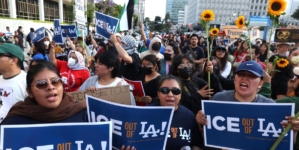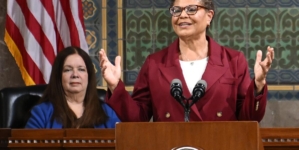-
The 'Belmont Stakes on FOX' crew make their picks for the winner of the Belmont Stakes - 8 mins ago
-
Missing Denver Hairstylist Found Dead After Two-Month Search—Family - 34 mins ago
-
Dodgers vs. Cardinals Highlights | MLB on FOX - 52 mins ago
-
Eagles DC Delivers Confident Message After Critical Losses - about 1 hour ago
-
Gaza families mark Eid al-Adha amid destruction and loss - 2 hours ago
-
A. P. Kid wins 2025 Pennine Ridge Stakes - 2 hours ago
-
Chaos erupts at Paramount Home Depot as protesters confront ICE - 2 hours ago
-
Riley Gaines and Simone Biles Beef Online Amid Trans Athlete Debate - 2 hours ago
-
Rod Stewart, 80, cancels 6 concerts as he battles the flu - 2 hours ago
-
Diamondbacks vs. Reds Highlights | MLB on FOX - 2 hours ago
California rolls out the nation’s first Southeast Asian curriculum
Long Beach is home to almost half a million Cambodian Americans — the largest population of Khmer people in the United States. Yet while attending classes at the Long Beach Unified School District, Savannah Thy said she rarely saw her own community represented in her daily lessons.
“The only time I was taught anything about Cambodia was the Khmer Rouge,” Thy said, referring to the communist regime that ruled the country in the 1970s. According to her history teachers, Cambodians were victims of genocide and war under that regime. There was no mention of the refugees who had formed a thriving community in Long Beach, nestled along the city’s Anaheim corridor called Cambodia Town.
“I believe that there’s so much more to our culture than just that piece of history,” Thy said.
But now, students across California will have a chance to learn about Cambodian Americans and other Asian communities through the Southeast Asian Studies Model Curriculum, which is the first of it’s kind in the country.
While not mandated, the state’s K-12th grade teachers can access dozens of suggested lesson plans for Hmong American, Vietnamese American and Cambodian American histories online to incorporate into their classrooms. The curriculum is available for teachers to use now, as a whole or in smaller segments.
“It’s really important to center the people who experienced those histories and cultures,” said Mariko Manos, the history and social sciences manager at the Orange County Department of Education, who spearheaded the creation of the curriculum for the California Department of Education. “To me, that’s what’s missing in our history books.”
The curriculum offers dozens of lesson plans that feature Asian Americans living in the diaspora and the histories of how they arrived in the U.S. — many as refugees of war.
“Most Americans have little understanding of … how the refugee community came to be formed in the U.S.,” said Khatharya Um, a professor of ethnic studies at UC Berkeley.
Um, who was a child refugee, said the U.S. hasn’t acknowledged its role in Cambodia’s collapse during the Vietnam War, and that has contributed to her community’s historical trauma.
“‘We are here because you were there,’” Um said, quoting the late activist and writer Ambalavaner Sivanandan on post-colonial migration. Cambodian, Laotian, Vietnamese and Hmong refugees are “the human legacies of the wars in which the U.S. was implicated.”
Chan Hobson, a survivor of the Cambodian genocide, speaks during “Stories of Resilience and Genocide Survival” at the convention in Long Beach.
(Michael Blackshire / Los Angeles Times)
What is significant to Um about this specific Southeast Asian curriculum is the conscious centering of community voices. The Orange County Department of Education sought Hmong, Vietnamese and Cambodian American feedback in dozens of iterative listening sessions as the foundation of their research.
Last month, the Orange County Department of Education hosted a two-day academic conference at the Long Beach Hilton to roll out the Cambodian American Model Studies Curriculum. Over 500 people were in attendance from as far away as Florida.
“The beauty of this project is that it’s built by the community and for the community,” said Tori Phu, one of the curriculum program specialists at the Orange County Department of Education.
Phu grew up in Santa Ana and visited Little Saigon every weekend with her family, but her parents were often reticent to speak about their experiences during the Vietnam War. The curriculum she hopes, fills a gap for children of refugees like herself, who never heard the full story.
“As you’re going through the curriculum, you’re hearing stories that might be related to your uncle, your aunt, your mom, your dad, your grandpa,” she said through happy tears.

Cambodia Town Chair Sithea San does a video interview during the Cambodia American Studies Conference last month at the Hilton Long Beach.
(Michael Blackshire / Los Angeles Times)
Teaching compassion
But Phu said the curriculum is also meant to engage students of all backgrounds who might relate to these stories.
“It’s not just for like the Vietnamese students or students that are born from Vietnamese refugees, that there’s a thread that can connect to other cultures too.”
Tauheedah Graham, a fifth-grade teacher from San Diego Unified School District, said the conference in Long Beach had broadened her perspective as an educator who isn’t Cambodian American.
“As an African American, I know that there’s my story. Then I [listened] stories of the Killing Field…the year I was born [in] 1979,” said Graham. “I think it just opens up the fact that we all just have so much trauma.”
Graham plans to share what she learned from the conference with her young students.

Sithary Ly holds a post card showing man dressed in traditional Cambodian clothing playing on skor thom drums.
(Michael Blackshire / Los Angeles Times)
An opportunity to heal and showcase resilience
For many scholars and activists, it felt like the new curriculum was their long-awaited acknowledgment after erasure and neglect had left Southeast Asian communities under-heard and underserved. Income inequality is highest among Asian Americans, according a 2018 study by the Pew Research Center. About 1 in 10 Asian Americans lives in poverty, but that rate is 17% of Hmong Americans and doubles to nearly 1 in 5 for Cambodian Americans.
“When you’re not aware of different communities and what they’ve gone through, we’re also not getting federal dollars to be able to fund different community initiatives,” said Laura Ouk, a writer on the Cambodian American curriculum.
Chia Vang, a history professor and vice chancellor of inclusion at the University of Wisconsin-Milwaukee, sees the three-pronged curriculum as a testament to the resilience of Southeast Asian communities. Her family resettled in St. Paul, Minn. — home to the highest concentration of Hmongs living in the U.S.
“People never thought that we would survive in this country because we were from a more agrarian background,” Vang said. “A curriculum like this is completely contradictory to these predictions. In fact, we have not only survived, but really thrive to tell our own stories in this fashion.”
While ethnic studies faces backlash nationally, other states like Wisconsin might follow California’s lead. Last year, Wisconsin Gov. Tony Evers signed a bill into law mandating Hmong American and Asian American studies in K through 12th-grade schooling.
Thy was raised by her grandmother, listening to stories about Cambodians and performing traditional Cambodian classical dances with the Modern Apsara Company. But she said a lot of Cambodian Americans haven’t had the same access to their culture and history.
“It’s very sad to see some kids my age not be able to talk to their grandparents because of the language barrier,” Thy said.
But she’s excited to see younger generations like her baby cousin have the chance to learn about their community through the curriculum.
“I’ve been waiting for this to happen for a very long time, and I’m just hoping that the next further generations will be able to know more about their culture,” Thy said.

Joy Okada, left, and Laura Ouk, right, pose for a portrait after speaking during “Cambodian American Studies into English Course: and Authentic Strategies and Approaches for Teaching Cambodian American History.”
(Michael Blackshire / Los Angeles Times)
Source link































